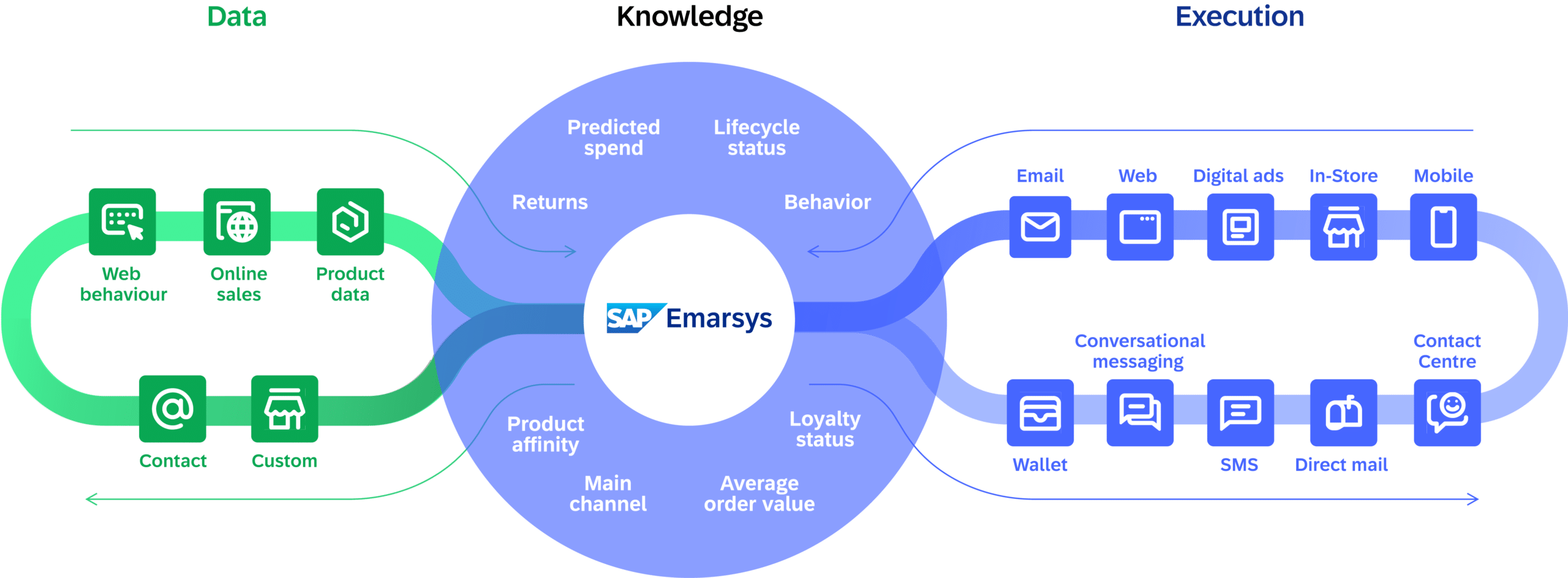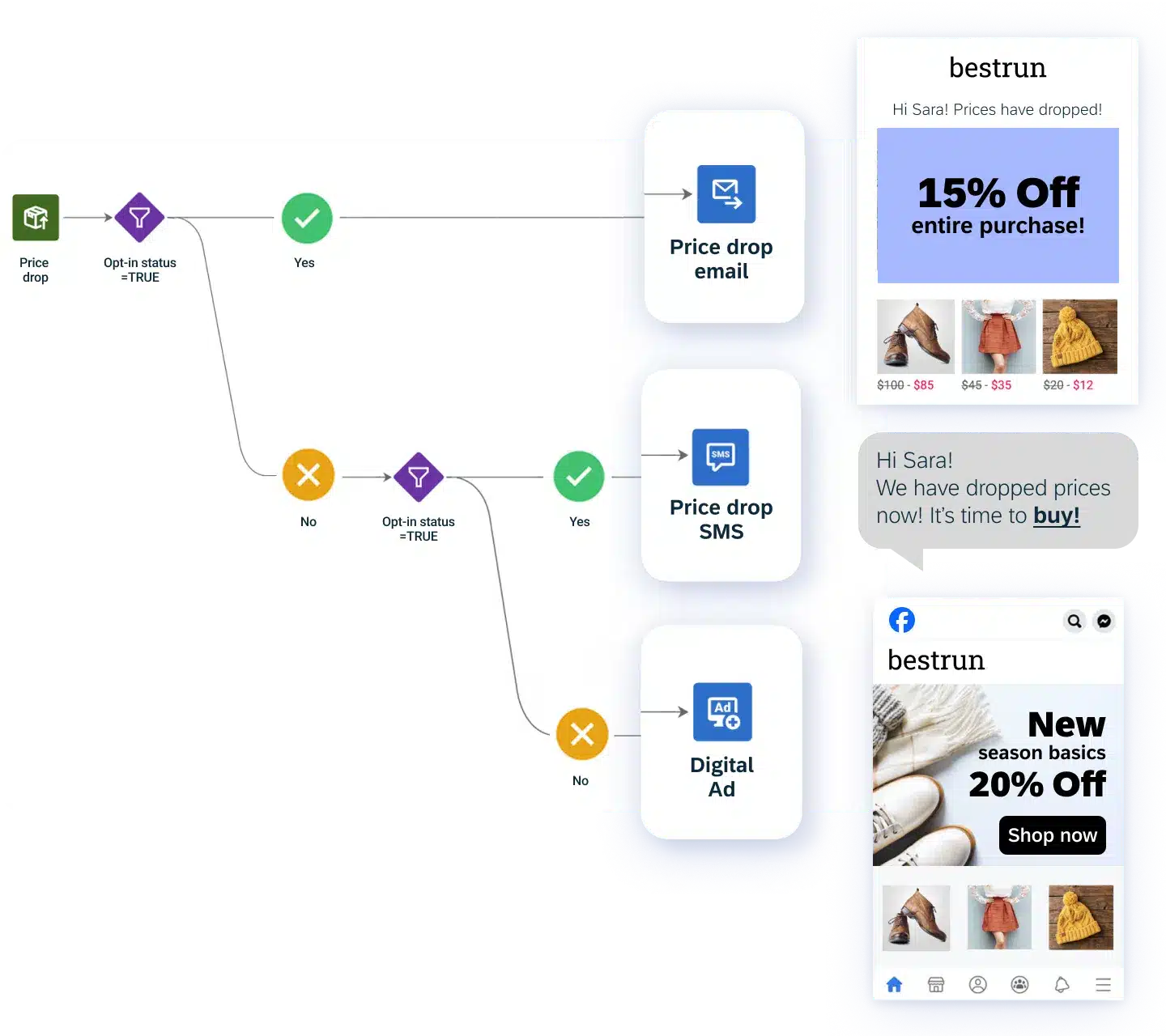Your customer browses your products on Instagram, checks prices on your website, opens your marketing email—but ultimately, they end up buying from your competitor.
All that time spent building your automated strategic emails, planning the perfect social content, down the drain. And unfortunately, this frustrating pattern often plays out hundreds –or even thousands – of times daily.
How can you break the cycle?
Here’s the good news. Companies that implement omnichannel strategies are seeing an average 18% sales increase. In this article, we’ll break down the very tactics that are transforming their customer experiences from fragmented touchpoints to free-flowing transactions.
What is Omnichannel Marketing?
Before delving into the tactics, let’s align on the concept. Omnichannel marketing is a strategy that delivers personalized and relevant experiences to customers, no matter what channel they’re on – whether it’s on the web, social media, in emails, apps, SMS, or other digital spaces.
Unlike multichannel marketing, which treats each channel as a separate entity, omnichannel marketing leverages machine learning, customer data platforms and advanced technologies to build a personalized and cohesive experience.

To illustrate this in action, let’s look at a multinational beauty retailer. Their goal is to build a fully integrated omnichannel experience that delivers hyper-personalized interactions that enhance customer engagement and fosters long-term loyalty.
- Social Media: A customer sees an Instagram post featuring a new line of organic skincare products. The post includes a link to learn more and a call-to-action to take a skincare quiz.
- Website: The customer clicks the link and is directed to the company’s website, where they complete the quiz. Based on their responses, the website recommends specific products and offers personalized skincare tips.
- Email: The customer receives an email summarizing their quiz results and product recommendations, along with exclusive offers for the recommended products. The email also reminds them of their Loyalty Points and encourages them to explore new arrivals.
- Mobile App: The customer downloads their app, which provides access to personalized recommendations, order tracking, and virtual try-on features. They use the app to virtually try on different lipstick shades.
- Physical Store: The customer visits a brick-and-mortar store location. Using the app, they check in to earn extra Loyalty points. A store associate greets them and, using the customer’s profile, offers assistance and product samples tailored to their skin type and preferences. The associate can also access the customer’s quiz results and online purchase history to provide relevant recommendations.
- SMS: After leaving the store, the customer receives an SMS message thanking them for visiting and offering a link to review the products they sampled.
- Loyalty Program: The Loyalty Program tracks all customer interactions across channels, rewarding them for purchases, engagement, and reviews. Points can be redeemed for exclusive products, experiences, and personalized services, reinforcing loyalty and encouraging repeat business.
When all these elements are working together, the customer experiences a delightful journey where each interaction feels personalized, relevant, and effortless—strengthening their relationship with the brand.
The Foundations of Omnichannel Mastery: 3 Core Tenets
A strong omnichannel marketing strategy rests on three core tenets: consistency, automation, and data connectivity. Like a stool that wobbles with an uneven leg, every omnichannel strategy must maintain balance across all three elements.
1. Consistency is key
Consistency plays a paramount role in your omnichannel success, and it begins with maintaining an identifiable brand. Every interaction a customer has with your business—whether through your website, social media, in-store visits, or customer service—should reflect the same visual elements, tone, and messaging. Why does this work? People are naturally drawn to brands they recognize because familiarity reduces perceived risk.
For example, using the most up-to-date taglines ensures that your messaging aligns with your current offerings and values, reinforcing your brand’s relevance. Even how you refer to your customers—whether as “clients,” “members,” or “partners”—should align with your brand’s voice and values to create a consistent identity that ‘feels’ like your brand.
2. Automation in action
Automation alleviates the frustrations of repetitive tasks and siloed data, ensuring businesses can respond in a relevant, timely and consistent manner. For example, automation enables businesses to track customer behavior across platforms—whether someone browses products on a mobile app or visits your website—and use that data to deliver personalized recommendations or promotions.
Automated workflows also allow businesses to send targeted communications, such as follow-up emails for abandoned carts or personalized offers based on previous purchases. That means even when it’s after hours for your team, your business is still firing on all cylinders and never missing a moment with your customers.

3. In-store and online convergence
Merging online and offline worlds creates significant advantages for both businesses and customers. How can you bring this convergence to life? Buy online, pick up in-store (BOPIS) blends online convenience with in-store immediacy, offering customers the best of both worlds in a single shopping trip. You might also consider implementing QR codes throughout your store—on product packaging, displays, posters, receipts, and digital screens.
These versatile tools enhance the customer experience by providing instant access to detailed product information, reviews, and exclusive offers. More than just a convenience, they offer retailers an accessible method to track key metrics, such as scan frequency, location, and timing. By bringing together data from all customer touchpoints, you can keep track of individual customer preferences, personalize the moments of your customer journey that matter, and create a memorable experience that builds trust and loyalty.
Omnichannel Success Stories: From Home Depot to High Fashion
To understand what these strategies look like rolled out, let’s take a look at two real-world examples:
The Home Depot’s omnichannel success: Increasing conversions by 8X
Home Depot Mexico faced the challenge of maximizing its impact during Hot Sale, a major online shopping event. They needed a strategy to attract new customers while building trust and loyalty. By partnering with SAP Emarsys, they were able to integrate data from various sources, allowing them to personalize customer experiences across channels.
Here’s how they created a winning customer experience:
- Unified data: Integrated online and offline data for a cohesive shopping experience.
- Personalized marketing: Implemented a welcome series for new customers, showcasing brand values, gathering preferences, and offering tailored content.
- Seamless omnichannel: Integrated solutions like BOPIS to bridge the digital-physical gap.
- Scaled engagement: Leveraged data and personalized marketing to manage high traffic and provide relevant experiences during Hot Sale.
As a result, the leading home improvement retailer store saw an increase in conversions by 8 times during their promotion period.
“You do things a certain way, you automate a certain way, you personalize a certain way. And this particular team [the SAP Emarsys Strategic Services Team] is specialized in showing you the different ways you can increase your engagement, make things better, or even integrate things that you didn’t know were possible before. So once you start doing that and you see the results, it’s just fantastic.”
Roman Originals’ Strategic Shift
During the pandemic, British fashion brand Roman Originals faced a crisis when their predominantly 50+ year-old customers, accustomed to in-store shopping, resisted moving online, causing sales to plummet. However, the company engineered a successful turnaround by addressing customer concerns about gift cards, store credit, and try-ons through a data-driven strategy.
By consolidating customer data across channels, implementing targeted omnichannel marketing, and adapting their messaging to meet evolving customer needs, Roman Originals not only recovered but built a foundation for continued revenue growth.
What’s Next for Omnichannel Marketing?
The future of omnichannel marketing is poised to become even more sophisticated and customer-centric. As artificial intelligence and machine learning capabilities advance, businesses will be able to create increasingly seamless experiences that anticipate customer needs before they arise.
In the coming years, we’ll likely see the lines between digital and physical shopping experiences blur even further, with technologies like augmented reality, voice commerce, and predictive analytics becoming standard tools in the omnichannel arsenal.
The key to success will remain the same: maintaining a strong foundation of data connectivity, consistency across channels, and automated processes that deliver personalized experiences at scale. Companies that invest in these capabilities now will be well-positioned to meet evolving customer expectations and drive growth in an increasingly competitive marketplace.
Ready to Jump-Start Your Omnichannel Customer Journey?
The SAP Emarsys omnichannel marketing platform supports a breadth of both native channels and an extensible ecosystem of best-in-class partner integrations that unlock additional revenue streams, scalability and innovation. Whether you’re just starting your omnichannel journey or optimizing specific touchpoints, there’s never been a better time to begin thinking about a more connected customer experience.







